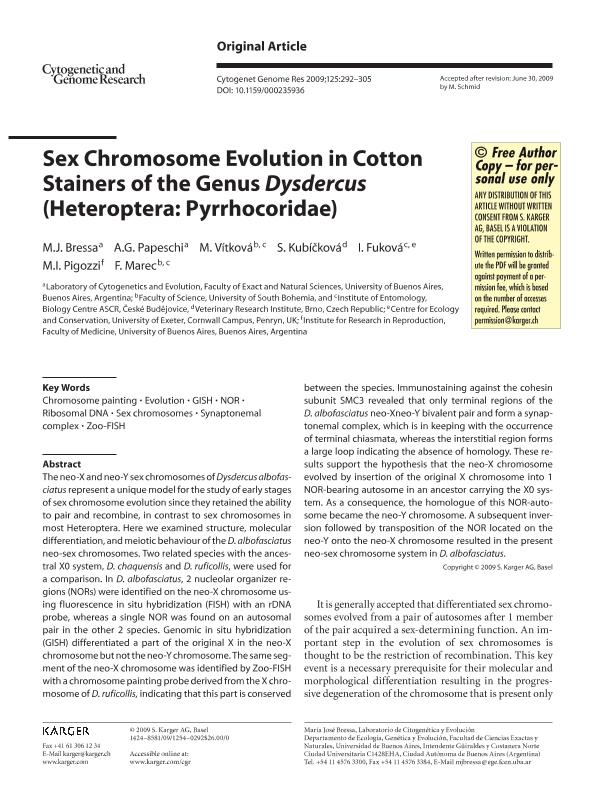Artículo
Sex chromosome evolution in cotton stainers of the genus dysdercus (Heteroptera: Pyrrhocoridae)
Bressa, Maria Jose ; Papeschi, Alba Graciela
; Papeschi, Alba Graciela ; Vítková, M.; Kubícková, S.; Fuková, I.; Pigozzi, Maria Ines
; Vítková, M.; Kubícková, S.; Fuková, I.; Pigozzi, Maria Ines ; Marec, F.
; Marec, F.
 ; Papeschi, Alba Graciela
; Papeschi, Alba Graciela ; Vítková, M.; Kubícková, S.; Fuková, I.; Pigozzi, Maria Ines
; Vítková, M.; Kubícková, S.; Fuková, I.; Pigozzi, Maria Ines ; Marec, F.
; Marec, F.
Fecha de publicación:
12/2009
Editorial:
Karger
Revista:
Cytogenetic And Genome Research
ISSN:
1424-8581
Idioma:
Inglés
Tipo de recurso:
Artículo publicado
Clasificación temática:
Resumen
The neo-X and neo-Y sex chromosomes of Dysdercus albofasciatus represent a unique model for the study of early stages of sex chromosome evolution since they retained the ability to pair and recombine, in contrast to sex chromosomes in most Heteroptera. Here we examined structure, molecular differentiation, and meiotic behaviour of the D. albofasciatus neo-sex chromosomes. Two related species with the ancestral X0 system, D. chaquensis and D. ruficollis, were used for a comparison. In D. albofasciatus, 2 nucleolar organizer regions (NORs) were identified on the neo-X chromosome using fluorescence in situ hybridization (FISH) with an rDNA probe, whereas a single NOR was found on an autosomal pair in the other 2 species. Genomic in situ hybridization (GISH) differentiated a part of the original X in the neo-X chromosome but not the neo-Y chromosome. The same segment of the neo-X chromosome was identified by Zoo-FISH with a chromosome painting probe derived from the X chromosome of D. ruficollis, indicating that this part is conserved between the species. Immunostaining against the cohesin subunit SMC3 revealed that only terminal regions of the D. albofasciatus neo-Xneo-Y bivalent pair and form a synaptonemal complex, which is in keeping with the occurrence of terminal chiasmata, whereas the interstitial region forms a large loop indicating the absence of homology. These results support the hypothesis that the neo-X chromosome evolved by insertion of the original X chromosome into 1 NOR-bearing autosome in an ancestor carrying the X0 system. As a consequence, the homologue of this NOR-autosome became the neo-Y chromosome. A subsequent inversion followed by transposition of the NOR located on the neo-Y onto the neo-X chromosome resulted in the present neo-sex chromosome system in D. albofasciatus.
Archivos asociados
Licencia
Identificadores
Colecciones
Articulos(IEGEBA)
Articulos de INSTITUTO DE ECOLOGIA, GENETICA Y EVOLUCION DE BS. AS
Articulos de INSTITUTO DE ECOLOGIA, GENETICA Y EVOLUCION DE BS. AS
Articulos(INBIOMED)
Articulos de INSTITUTO DE INVESTIGACIONES BIOMEDICAS
Articulos de INSTITUTO DE INVESTIGACIONES BIOMEDICAS
Citación
Bressa, Maria Jose; Papeschi, Alba Graciela; Vítková, M.; Kubícková, S.; Fuková, I.; et al.; Sex chromosome evolution in cotton stainers of the genus dysdercus (Heteroptera: Pyrrhocoridae); Karger; Cytogenetic And Genome Research; 125; 4; 12-2009; 292-305
Compartir
Altmétricas



